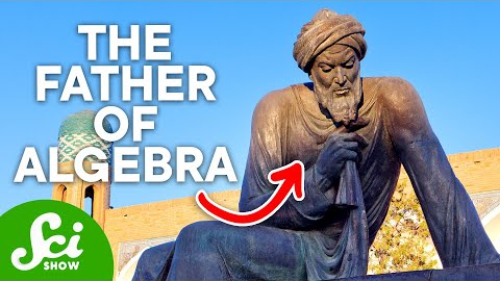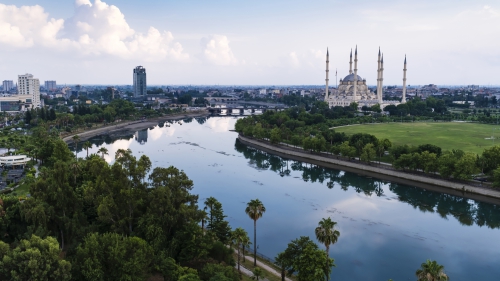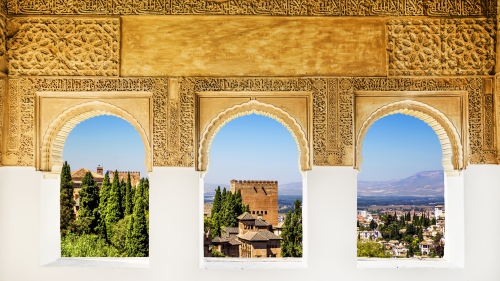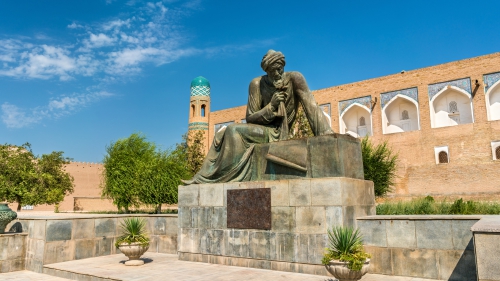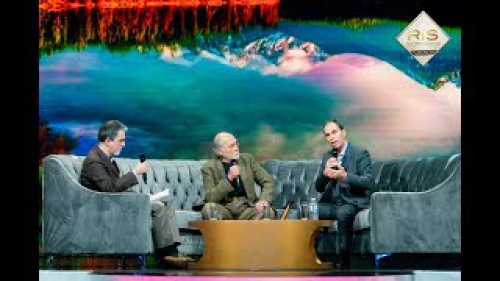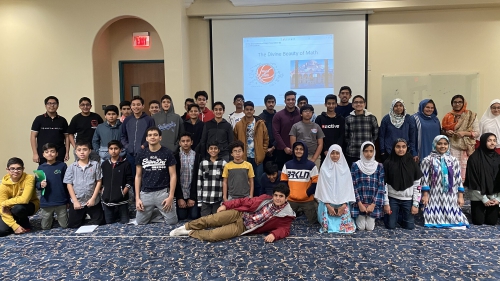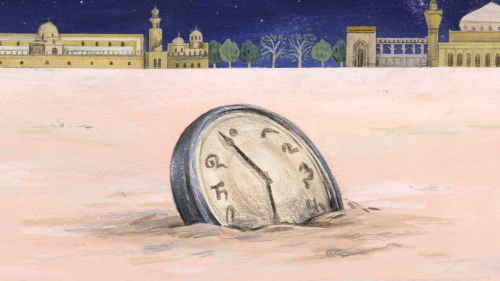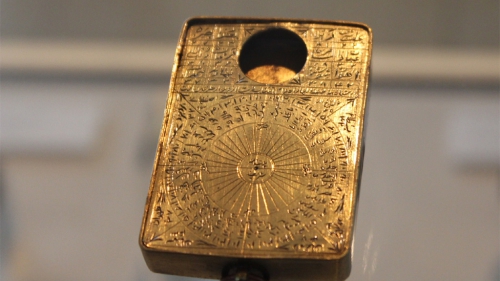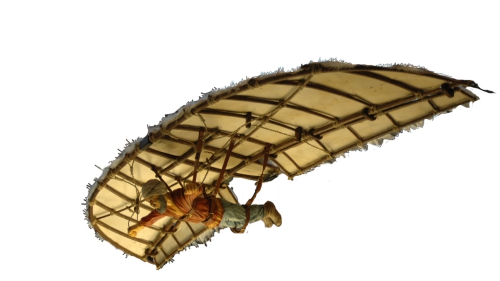Springs of Islamic civilization

Al-Khwarizmi
The springs which fed Islamic civilization sprang from many lands. Symptomatic of this is the fact that the family of its greatest early scientist, the Central Asian scholar Muhammad ibn Musa al-Khwarizmi, came from the old and high civilization that had grown up in the region of Khwarizm. This is the ancient name for the region around Urgench in the U.S.S.R., a city near the delta of the Amu Dar'ya (Oxus) River on the Aral Sea.
Al-Khwarizmi served the Caliph al-Ma'mun in the House of Wisdom and is connected to a later caliph, al - Wathiq (842 - 847), by the following story told by the historian al - Tabari. It seems that when al-Wathiq was stricken by a serious illness he asked al-Khwarizmi to tell from his horoscope whether or not he would survive. Al- Khwarizmi assured him he would live another fifty years, but al-Wathiq died in ten days. Perhaps al-Tabari tells this story to show that even great scientists can make errors, but perhaps he told it as an example of al- Khwarizmi's political astuteness. The hazards of bearing bad news to a king, who might mistake the bearer for the cause, are well known.
Al-Khwarizmi's principal contributions to the sciences lay in the four areas of arithmetic, algebra, geography and astronomy. In arithmetic and astronomy he introduced Hindu methods to the Islamic world, while his exposition of algebra was of prime importance in the development of that science in Islam. Finally, his achievements in geography earn him a place among the ancient masters of that discipline.
His arithmetical work The Book of Addition and Subtraction According to the Hindu Calculation introduced the very useful decimal positional system that the Hindus had developed by the sixth century A.D., along with the ten ciphers which make that system, the one we use today, so convenient. His book was the first Arabic arithmetic to be translated into Latin, and its influence on Western mathematics is illustrated by the derivation of the word algorithm. This word is in constant use today in computing science and mathematics to denote any definite procedure for calculating something, and it originated in the corruption of the name al- Khwarizmi to the Latin version algorismi.
Al-Khwarizmi's book had an equally important effect on Islamic mathematics, for it provided Islamic mathematicians with a tool that was in constant - though not universal - use from the early ninth century onward. From the oldest surviving Arabic arithmetic, Ahmad al-Uqlidisi's Book of Chapters, written ca. A.D. 950, to the encyclopedic treatise of 1427 by Jamshid al-Kashi, The Calculators' Key, decimal arithmetic was an important system of calculation in Islam. By the mid-tenth century Ahmad b. Ibrahim al-Uqlidisi solved some problems by the use of decimal fractions in his book on Hindu arithmetic, so that in a little over a century al- Khwarizmi's treatise had led to the invention of decimal fractions. These too were used by such Islamic mathematicians as al-Samaw'al ben Yahya al-Maghribi in the twelfth century to find roots of numbers and by al-Kashi in the fifteenth century to express the ratio of the circumference of a cirlce to its radius as 6.2831853071795865, a result correct to sixteen decimal places.
 |
| Islamic Art & Patterns inspired by mathematic precision |
Arithmetic was only one area in which al- Khwarizmi made important contributions to Islamic mathematics. His other famous work, written before his Arithmetic, is his Kitab al-jabr wa l-muqabala (The Book of Restoring and Balancing), which is dedicated to al-Ma'mun. This book became the starting point of the subject of algebra for Islamic mathematicians, and it also gave its title to serve as the Western name for the subject, for algebra comes from the Arabic al-jabr. In this book a variety of influences are evident, including Babylonian and Hindu methods that lead to solutions of what we would call quadratic equations and Greek concerns with classification of problems into different types and geometrical proofs of the validity of the methods involved.
The synthesis of Oriental procedures with Greek proofs is typical of Islam, as is the application of a science to religious law, in this case the thorny problems posed by Islamic inheritance law. A large part of the book is devoted to such problems, and here again al- Khwarizmi's example became the model for later Islamic writers. Thus, after the time of al- Khwarizmi, Abu Kamil, known as "The Egyptian Reckoner", also wrote on the application of algebra to inheritance problems.
Finally, we must comment on al- Khwarizmi's contribution to the science of cartography. He was part of the team of astronomers employed by al-Ma'mun to measure the length of one degree along a meridian. Since the time of Aristotle (who wrote in the middle third of the fourth century B.C.), men had known that the earth was spherical and, hence, that multiplication of an accurate value for the length of one degree by 360 would lead to a good estimate for the size of the earth. In the century after Aristotle the scientist Eratosthenes of Alexandria, who was the first scientist to be appointed Librarian of the famous library in that city, used this idea with his knowledge of mathematical astronomy to obtain an estimate of 250,000 stades for the circumference of the earth. This was later shortened by an unknown author to 180,000 stades, a figure far too small but adopted by the astronomer, Klaudios Ptolemaios (Ptolemy) in his Geography.
We know that the Hellenistic stade is approximately 600 feet but this was not known to the caliph al-Ma'mun. As al-Biruni says in his Coordinates of Cities, al-Ma'mun "read in some Greek books that one degree of the meridian is equivalent to 500 stadia..... However, he found that its actual length [i.e. the stade's] was not sufficiently known to the translators to enable them to identify it with local standards of length." Thus al-Ma'mun ordered a new survey to be made on the large, level plain of Sinjar some 70 miles west of Mosul, and two surveying parties participated. Starting from a common location one party traveled due north and the other due south. In the words of al-Biruni:
Each party observed the meridian altitude of the sun until they found that the change in its meridian altitude had amounted to one degree, apart from the change due to variation in the declination. While proceeding on their paths, they measured the distances they had traversed, and planted arrows at different stages of their paths (to mark their courses). While on their way back, they verified, by a second survey, their former estimates of the lengths of the courses they had followed, until both parties met at the place whence they had departed. They found that one degree of a terrestrial meridian is equivalent to fifty-six miles. He (Habash) claimed that he had heard Khalid dictating that number to Judge Yahya b. Aktham. So he heard of that achievement from Khalid himself.
Again one sees an Islamic side to this project in the involvement if a jurist, for the law was the Islamic religious law and in this case the jurist (qadi in Arabic) was the chief justice of Basra, Yahya b. Aktham. Al-Biruni goes on to say that a second result was also obtained by the survey, namely 56 2/3 miles/degree, and in fact al-Biruni uses this value in his own computations later on.
|
This article is excerpted from the book "Episodes in the Mathematics of Medieval Islam" by J. L. Berggren. |
Al- Khwarizmi's contribution went beyond this to assist in the construction of a map of the known world, a project that would require solving three problems that combined theory and practice. The first problem was mainly theoretical and required mastery of the methods, such as those explained by Ptolemy in the mid-second century A.D., for mapping a portion of the surface of a sphere (the earth) onto a plane. The second was to use astronomical observations and computations to find the latitude and longitude of important places on the earth's surface. The difficulties involved here are both theoretical and practical. The third problem was to supplement these observations by reports of travelers (always more numerous and usually less reliable then astronomers ) on journey-times from one place to another. Among al-Khwarizmi's achievements in his geographical work The Image of the Earth were his correction of Ptolemy's exaggerated length of the Mediterranean Sea and his much better description of the geography of Asia and Africa. With such a map the caliph could survey at a glance the extent and shape of the empire he controlled.
Thus it was that on his death al-Khwarizmi's legacy to Islamic society included a way of representing numbers that led to easy methods of computing, even with fractions, a science of algebra that could help settle problems of inheritance, and map that showed the distribution of cities, seas and islands on the earth's surface.
This article is excerpted from the book "Episodes in the Mathematics of Medieval Islam" by J. L. Berggren. Click the Amazon image above to buy this book.
Topics: Al Khwarizmi, Mathematics, Muslim Civilizations
Views: 10499
Related Suggestions
The world must know that Muslims created natural sciences & did not copy them from the Greeks and the Indians. They did not specualate like the Greeeks did for instance; they observed, analysed, tested and establised the laws of natural & medical & mathematic sciences etc. Just like their ancestors were masters in poetry, they were masters in sciences. The difference between the West and the Muslim World is that the Muslims did not develop capitalism out science! Research was done mainly as a religious duty. For the West, science was meant to demystify the mysterious & to break away from religion; to change the world and control it. And first and foremost to sometimes challenge God and most of the time to weaken if not to destroy the Church.
Allah knows best!
Khwarizmi is an persian Muslim scientist , since at the time the central Asia was part of Persia that was seprated 200 years ago by force from the country that rigth now called Iran and still is a pillar of Islam in the recent era.
best
Journalist
I have the beleive that islam is going to rule the world at the end whether the non beleiver agreed or not. Islam is for all.
All regions or reginal thinking R building blocks
to understanding & becoming part of a sharred
cloth. Mythology Tales with Morals, Tao poems, Shinto Outline (see, hear, speak no evil), Budda Wisdom, Essene (horsemen, cave & mountain) Teachers should be looked at & thanked, also.
Is it possible that when Ceizing Ceizer come 2 conquer, he appointed this Politically Agressive JUdas* to become Governor of the 2 leftover Jacobian Tribes. There were two possible leaders
who were coming out from the EssenE Priests:
(1) Jesus, who had a call 4 teaching & telling wise storys.
(2) JUdas, who left early, with an obvious great
urge 4 power.
After Ceazar, JUdas+their Court of 300 had Jesus+Mary out of the way, it left the brick road open 4 JUdas who brought together the two
tribes from two different but nearby areas, but
they eventually intermarried, or left the area.
It is said that Moses wrote Duteronomy.
It is said that the Greeks wrote Genesis.
It is written that Ibraham had 8children (of course Issiac (Yitchek) was adopted from his brother & sister, Nachor & Milchek. Issiac's elder son, Esaw married Ishmale's daughter.
So, where R Ibraham's other children, please?






